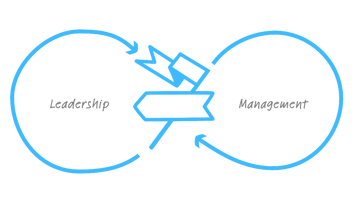Without any doubt, leadership is one of the most discussed topics in management research and practice. Depending on the research stream and the practical focus, there are many different meanings of and associations with the terms “leader” and “leadership”, and no single universally accepted definition. While working on our Leadership Development Kit – a collection of research-based resources and tools for practitioners to build leadership capabilities in their own organization – we’ve had to clarify our point of view and position ourselves with regard to the different perspectives on leadership.
There are three main streams in leadership research that are worth considering to better understand and develop leadership in practice.
Leadership as a leader’s traits or capabilities
The first – and historically dominant – approach defines leadership as connected to the personal traits and abilities of an individual leader, such as task competences (i.e., intelligence or functional skills) or interpersonal attributes (cooperation abilities, persuasiveness, etc.). From this point of view, leadership (as in good leader performance) is the result of something an individual possesses in the form of certain desirable attributes. And it’s those attributes that differentiate a leader from other people.
In contrast to the concept of leadership stemming purely from a leader’s traits (“what leaders are”), recent research has focused on the importance of certain acquirements or capabilities and relatedly the correlation of skills or capabilities (“what leaders can accomplish”):
By focusing on leadership skill requirements, the focus is shifted from the person holding the job (i.e., the leader) to the job itself. Thus, instead of attempting to identify the characteristics of leaders (which has had a checkered history of success), the focus is squarely on the job of the leader, and the skills it requires. (Mumford et al., 2007: 154–155)
This shift from focusing on traits to focusing on capabilities raises the question of how and to what degree leadership attributes and skills can be developed and learned, and whether they depend on an individual’s personality and qualifications.
Leadership as a leader’s way to play
A second approach looks at leadership from a behavioral perspective, examining how leaders act and with what outcomes. A functional perspective defined leadership increasingly in terms of achieving a group’s objectives and identified leaders as those people who lead and support others in achieving the group’s goals. Behavioral research approaches then started to look more closely at everything that happens in this goal-achieving process as well as to a leader’s engagement with others.
If leadership is mostly a question of behavior in a certain context, then leadership capabilities and skills can be learned and trained through experience. And leadership can be mirrored once it’s broken down into classifications, such as behavioral patterns, i.e., patterns that can be framed, for example, as task-oriented, people-oriented, change-oriented, or strategic behaviors. And if we take this one step further, patterns can be classified into different leadership roles (for example delegating, directing, supporting, coaching, reflecting) and of course into the often referenced leadership styles. Through simplification, researchers and practitioners thereby classify leaders’ behaviors as autocratic, bureaucratic, transactional, laissez-faire, democratic or charismatic leadership styles.
Leadership as emerging from leader-follower relationships
A third approach can be roughly clustered under the headline of relational perspectives, and focuses on the aspects of leadership that happen in interpersonal connections – in contrast to both the “leadership as traits/skills” and “leadership as behavior” approaches, which focus on individual leaders.
Interpersonal perspectives address the social mechanisms that take place in leadership processes and focus on how leadership has impact, whether it’s in hierarchical top-down/bottom-up or more lateral and integrated structures.
Leadership is a process of influence between a leader and those who are followers. (Hollander, 1978: 1)
Situational, contingent, flexible, and adaptive streams of leadership research take further into account the contextuality, the changing requirements of leadership situations, the different people in those situations, and the necessary respective ways leaders must adapt to those circumstances.
Leadership is an interaction between two or more members of a group that often involves a structuring or restructuring of the situation and the perceptions and expectations of members… Leadership occurs when one group member modifies the motivation or competencies of others in the group. (Bass, 1990: 19–20)
Leader-follower relations, dynamics of power and influence, cultural factors, and a stronger focus on the collective level of leadership all play important roles within this interpersonal perspective on leadership. Collaborative and communication factors, such as feedback, facilitation, and decision-making processes, lie at the core of more interactive viewpoints of leadership.
Transformational and charismatic leadership are largely popular relational streams that emphasize the leader's role in supporting a shared vision, purpose, identity, and motivation:
Transformational leaders are those who stimulate and inspire followers to both achieve extraordinary outcomes and, in the process, develop their own leadership capacity. Transformational leaders help followers grow and develop into leaders by responding to individual followers’ needs by empowering them and by aligning the objectives and goals of the individual followers, the leader, the group, and the larger organization. (Bass & Riggio, 2006: 3)
More recently discussed research trends, such as authentic, servant or spiritual leadership, are further working out ethical (motives, values) and (self-)reflective components of leadership in strong correlation within evolving organizational settings.
Our central premise is that through increased self-awareness, self-regulation, and positive modeling, authentic leaders foster the development of authenticity in followers. In turn, followers’ authenticity contributes to their well-being and the attainment of sustainable and veritable performance. (Avolio & Gardner, 2005: 317)
The question of how to set up and develop the organizational structures and processes where leadership can thrive – leadership that isn’t exclusively linked to single individuals and formal ranks or roles – is becoming more important altogether.
Leadership is a social and mutual influence process where multiple actors engage in leading-following interactions in service of accomplishing a collective goal. (DeRue & Myers, 2014: 834)
From a contemporary research perspective, leadership is viewed as a dynamic process that considers the whole organization. As a result, there’s a sharper focus on shared leadership, which views leadership as collective, distributed power. This emphasis within the leadership development literature takes place as part of a broader development, in which (cross-functional) teams become highly prominent organizational units and crucial drivers for success. It’s a development that calls for more self-organized and agile organizations that aren’t so dependent upon single leaders but function as collectively strong systems. Systems in which, for example, decisions are made in a responsive way, and in consideration of where the knowledge and expertise are located rather than depending merely upon seniority or rank of decision makers.
Of course research on leadership development is ongoing and there are many aspects that we haven’t discussed in this brief overview. Got something to add to this blog post? Let us know in the comment section!
To get a more detailed overview of the different aspects and concepts with respect to leadership development, stay up to date with the Management Kits Blog and subscribe to our newsletter.
Ready to start working on your own leadership development strategy?
Check out our Leadership Development Kit!
References:
Avolio, B.J. & Gardner, W.L. 2005. Authentic leadership development: Getting to the root of positive forms of leadership. The Leadership Quarterly, 16: 315–338.
Bass, B. M. (1990). Bass and Stogdill’s handbook of leadership: Theory, research and managerial applications (third ed.). New York: Free Press.
Bass, B. M. & Riggio, E. G. (2006). Transformational Leadership (second ed.). Mahwah, NJ: Lawrence Erlbaum Associates.
DeRue, D. S. & Myers C. G. (2014). Leadership Development: A Review and Agenda for Future Research. In Day, D. (Ed.), Oxford Handbook of Leadership and Organizations, 832–855. New York: Oxford University Press.
Hollander, E. P. (1978). Leadership dynamics: A practical guide to effective relationships. New York: Free Press.
Mumford, T. V., Campion, M. A. & Morgeson, F. P. (2007). The leadership skills strataplex: Leadership skill requirements across organizational levels. The Leadership Quarterly, 18: 154–166.



